A series of mysterious and uncanny architectural, artistic, and religious parallels connect the ancient Maya and Egyptian civilisations. Some of these parallels have been noted and proclaimed by nineteenth century scholars; others have been discovered in the past several decades. Over the past twenty-five years of research into ancient civilisations, I’ve uncovered and explained many such parallels, and have come to believe that these parallels are more than mere coincidences.
Such close parallels are enigmatic, even problematic, as the Maya and Egyptians sprung up independently on opposite sides of the Atlantic Ocean (pre-classic Maya in the Yucatan c. 2000 BC vs. dynastic Egyptians in Africa c. 3150 BC). The two cultures don’t appear to have been in contact, as there are no records of trade, war, or communication between them. How, then, can we explain the similarities?
Faced with this enigma, many Victorian-era scholars and archaeologists believed that the Maya and Egyptians were children of the same mother culture—an advanced civilisation so old that memory of its existence has been lost to time. Such theories went out of vogue well over a century ago, but I believe that this rejection was premature, for reasons outlined in my latest book and reviewed briefly here.
Ever since my first back-to-back research trips to Egypt (1996) and Mexico (1997), I’ve been discovering, researching, and presenting profound cultural parallels shared by ancient civilisations worldwide. The Maya/Egyptian parallels are among the most striking.
Some of these parallels were recognised by Victorian and pre-Victorian era scholars and writers like Charles Etienne Brasseur de Bourbourg, Edward Herbert Thompson, Augustus Le Plongeon, Ignatius Donnelly, and Zelia Nuttall. Many of these scholars credited Plato’s lost continent of Atlantis with being the source of the similarities. Other parallels I’ve discovered through my own original research and investigation.
The Victorian-era idea that the lost continent of Atlantis was the source of the parallels (i.e., a theory called “diffusion”) has fallen out of favour with scholars over the past several decades. As a result, nineteenth century ideas have been shelved in favour of a new theory called “independent invention,” which holds that ancient inventions, such as pyramid construction, naturally occurred in more than one place at the same or different times. As the Paul McCartney/Michael Jackson duet “Ebony and Ivory” put it, “people are the same wherever you go.” This “independent invention” theory has notably been maintained by modern scholars like Kenneth Feder, professor of archaeology at Central Connecticut State University.
In my 2011 book Written in Stone, I revived the theory of the Victorian-age scholars, and took their work a step further, by exploring new evidence for the possibility that a primordial “Mother Culture”—now lost to time—flourished during a prehistoric “Golden Age.” In my subsequent books, articles, videos and lectures, I explained how this Golden Age was documented by the Hindus, Greeks, Romans, Aztecs, and other ancient civilisations; and I hypothesised that this Mother Culture may have been the source of the parallels shared by the world’s first cultures—a kind of “missing chapter” in the human story, as Graham Hancock puts it.
Are the following “10 Mayan & Egyptian Parallels” evidence that a sophisticated Golden Age civilisation—now almost completely forgotten—once existed in the ancient past, and was a kind of “Mother Culture” to the world´s first “known” cultures, like the Egyptians and Maya?
10 – Parallel Pyramids & Stone Serpents
Both the Maya and the Egyptians built pyramids. In fact, both cultures didn’t just build pyramids, they built similar “step pyramids” (i.e., pyramids with a series of steps leading upward toward the apex), as we can see here.
What’s more, there is clear evidence that both Egypt’s and Mexico’s “step pyramid” builders engaged in a kind of “serpent cult.” Because of its ability to shed its skin, the serpent symbolises regeneration and rebirth—concepts shared by both the Egyptians and Maya. We´re told by scholars that these concepts figured prominently in their metaphysical beliefs of eternal life, and life after death. With this in mind, it is especially interesting to note that not only did both the Egyptians and Maya build similar “step pyramids,” but they also crafted similar “stone serpents,” which are visible within sight of their parallel step pyramids. We can see examples of this in the photo below:
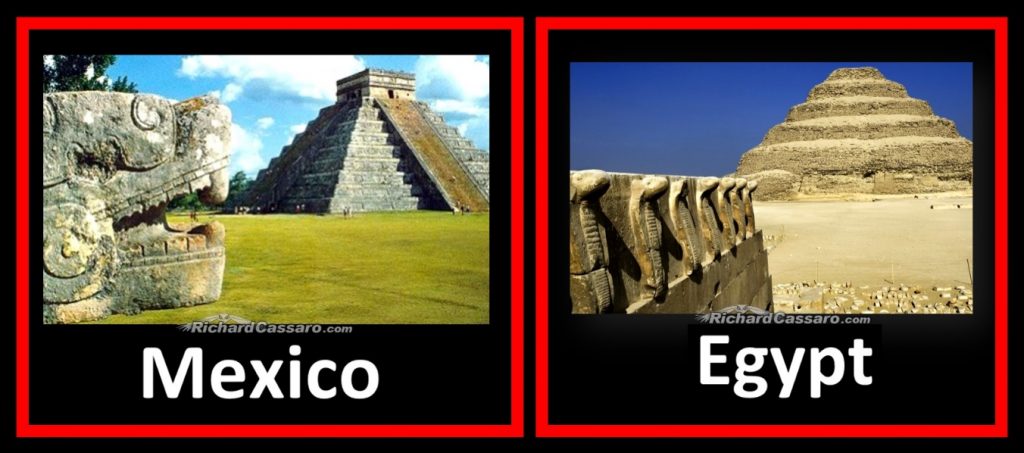
Left: a stone serpent within sight of the step Pyramid of Kukulkan at Chichen Itza, Mexico. Right: a series of stone serpents within sight of the step Pyramid of Saqqara, just outside Cairo, Egypt.
What are the chances that two unrelated civilisations separated by the Atlantic Ocean would have come up with not only “step pyramids,” but also adjacent or nearby stone serpents?
By itself, this “step pyramid/stone serpent” parallel is interesting, but certainly not dispositive or definitive proof of a direct link between the two civilisations. But there’s more, much more.…
9 – Similar Elongated Skulls
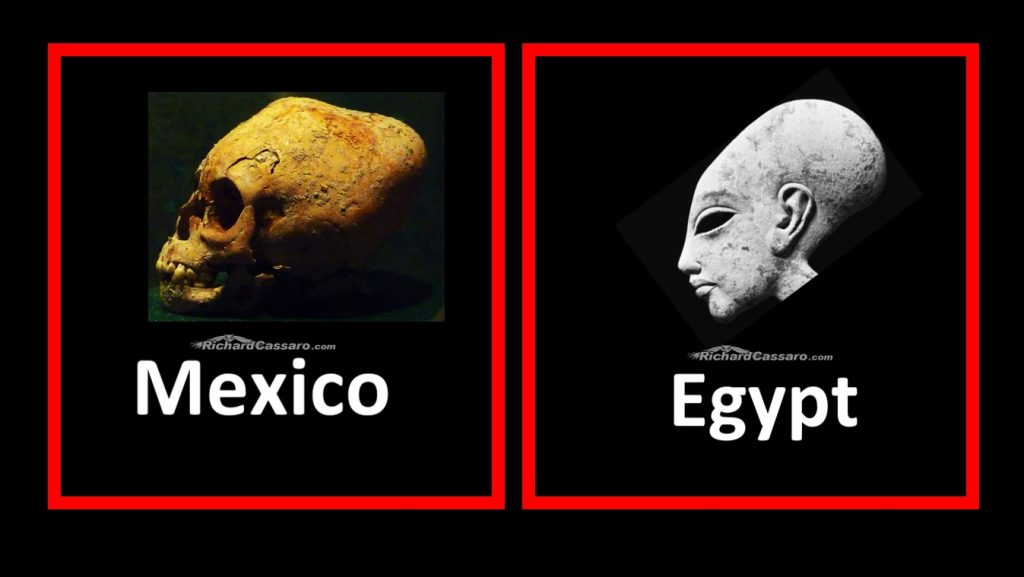
Left: Maya modified skull at the Museo Nacional de Antropología e Historia, México (Photo Courtesy of Museo Nacional de Antropología e Historia, México). Right: Elongated skull, described by Egyptologists as the child of Amenophis IV/Akhenaten (Photo Courtesy of The Walters Art Museum).
The parallel Mayan/Egyptian phenomenon of elongated skulls and cranial deformation has been known to scholars for centuries. Among both the Maya and the Egyptians, the practice seems to have been performed to differentiate the elite from the lower classes.
The earliest descriptions of cranial deformation among the Maya were reported by Spanish chroniclers in the 16th century. In 1843, the American explorer John L. Stephens published Incidents of Travel in Yucatán, describing an artificially deformed skull that he found during one of his excavations. The nineteenth century archaeologist Augustus Le Plongeon (1826 – 1908), in his book Queen Moo and The Egyptian Sphinx, described the practice among the peoples of the Mayan cities of Copan and Palenque. Popular authors like Ignatius L. Donnelly (1831 – 1901), in his book Atlantis: The Antediluvian World, elaborated on Le Plongeon’s analysis.
According to an article written by a series of doctors entitled “A Look at Mayan Artificial Cranial Deformation Practices: Morphological and Cultural Aspects,” which was published in December 2010 in the journal Neurosurgical FOCUS, the Mayan practice of cranial deformation served to differentiate the elite from the common classes:
“Induced deformation of the cranial vault is one form of permanent alteration of the body that has been performed by human beings from the beginning of history as a way of differentiating from others…High-ranking Mayan families of the Classic period differentiated themselves from the lower classes with their head shape. This social hierarchy can be seen in pottery, figurines, drawings, monuments, and architecture, where characters with oblique deformation are dominant.”
—A Look at Mayan Artificial Cranial Deformation Practices: Morphological and Cultural Aspects.
The idea that the Mayan elite practiced cranial deformation is interesting because the Egyptian elite also seem to have performed a skull elongation technique, possibly for the very same reason of differentiating themselves from the lower classes or common people. Shown in the example above is a statue of an elongated skull from Egypt’s Amarna Period, the era of the reign of Akhenaten (1353-1336 BCE). The skull is described by scholars as belonging to the daughter of the Egyptian Pharaoh Amenophis IV, also known as Akhenaten. Artwork featuring Akhenaten’s daughters, Nofernoferuaton and Nofernoferure, with elongated skulls (c. 1375-1358 BC) is repeated in other pieces of Amarna art.
Do the elongated skulls of both the Egyptian and Mayan “elite” point to a connection between the two civilisations?
There is also evidence of real-life cranial deformation in Egypt, as described in a report titled “The Sociopolitical History & Physiological Underpinnings of Skull Deformation,” published by the Department of Neurological Surgery, Columbia University College of Physicians & Surgeons. Interestingly, the report calls for more attention to be given to the “sociopolitical implications” of the practice. The report abstract states the following:
“In this report, the evidence, mechanisms, and rationale for the practice of artificial cranial deformation (ACD) in ancient Peru and during Akhenaten’s reign in the 18th dynasty in Egypt (1375-1358 BCE) are reviewed. The authors argue that insufficient attention has been given to the sociopolitical implications of the practice in both regions.”
— The Sociopolitical History & Physiological Underpinnings of Skull Deformation,” Columbia University College.
Admittedly, the idea that both the Mayan and Egyptian elite practiced cranial deformation to perhaps differentiate them from the lower classes does not directly connect the two civilisations. However, the fact that the pyramid-building Egyptians and Maya both practiced this strange technique is certainly provocative and indicates the possibility of a connection.
8 – Parallel Corbeled Vault Arches

Left: Example of a Mayan corbelled arch in Copan, Honduras. Right: Example of Egyptian corbelled arch inside the Red Pyramid near Cairo, Egypt.
The corbel arch was used in both Mayan and Egyptian architecture. A corbel arch (also called “corbeled” or “corbelled arch”) is an arch that uses the so-called “corbeling” construction method to span a space or void. A corbeled arch is constructed by offsetting successive courses of stone (or brick) in such a way that they project towards the archway’s centre from each supporting side, until the courses meet at the archway’s apex. The gap at the apex is then bridged with a flat stone.
The work of pioneering nineteenth century archaeologist and intrepid explorer Augustus Le Plongeon has largely been discredited because of its diffusionist basis. Le Plongeon insisted that the parallel corbeled arch was evidence that the world’s first cultures were children of a much older civilisation named Atlantis. Le Plongeon believed that the universality of the corbel arch in antiquity was strong evidence of shared wisdom across the Atlantic Ocean.
The scholar Lawrence G. Desmond, after receiving his PhD in anthropology and archaeology from the University of Colorado, Boulder, carried out archaeological research in Mexico and Guatemala for more than forty years. He is regarded as a leading scholar in the field of Maya archaeology. While expressing some reservations about Le Plongeon’s over-active imagination in an article chronicling Le Plongeon’s “downfall,” Desmond nonetheless appreciated the significance and essential correctness of Le Plongeon’s ideas regarding the corbeled arches shared by the Maya and Egyptians. Desmond credits Le Plongeon for pointing out parallels that (until now) have not yet been sufficiently explained:
“…Augustus Le Plongeon, a pioneering Mayanist, renowned for having made the earliest thorough and systematic photographic documentation of archaeological sites in Yucatan…
…for Le Plongeon, the most important evidence of cultural diffusion was the Mayas’ corbelled arch. The arches…he believed, had proportions that related to the “mystic numbers 3.5.7” which he stated were used by ancient Masonic master builders…Those same proportions, he also noted, were found in tombs in Chaldea and Etruria, in ancient Greek structures and as part of the Great Pyramid in Egypt… He was basically on the right track methodologically, and he did make a number of intriguing observations and analogies…”
—Lawrence G. Desmond, Augustus Le Plongeon: A Fall From Archaeological Grace.
7 – Similar Hieroglyphic Writing

Left: Example of Maya glyphs in the museum at Palenque, Mexico. Right: Egyptian Hieroglyphs from the tomb of Seti I, c. 13th century BC.
The Egyptians and Mayans both used hieroglyphs, consisting of pictographs or symbols, to express meaning in written language. Mayan writing, which is often described by scholars as the most sophisticated writing system in the pre-Columbian Americas, was dubbed “hieroglyphics” (or hieroglyphs) by early eighteenth and nineteenth century European explorers, including Augustus Le Plongeon, who noticed its similarity to Egyptian hieroglyphics.
Egyptian hieroglyphs consist of phonograms, which are placed at the beginning of words to represent sounds, whereas ideograms are used to represent objects or ideas. Mayan hieroglyphs consist of pictographs written in neat blocks that include phonograms and ideograms.
Is it possible that Mayan and Egyptian glyphs both evolved from the same “proto-language” or that perhaps one of them may have in fact served as an origin for the other?
Obtaining a satisfactory answer to that question depends on the successful decryption of Maya writing, which has been made vastly difficult by the bonfires of the sixteenth century christian Conquistadors, who regarded the precious and irreplaceable Mayan scrolls as the work of the devil.
6 – Similar Scenes & Motifs
There are many similar scenes and motifs that link the Mayan and Egyptian civilisations, too many to list all of them here. For purposes of this discussion, I’ve narrowed down to three particularly powerful motifs:
(A) the Smiting Scene
(B) the Initiation Scene
(C) the Twin Serpent Motif.
(A) PARALLEL SMITING SCENE
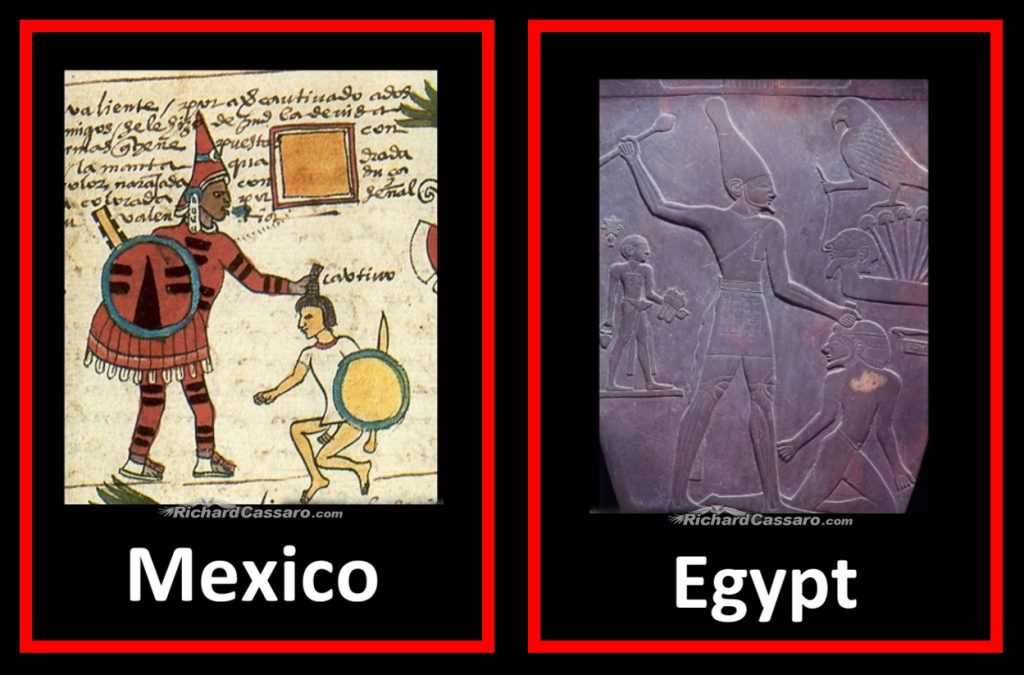
Left: The Codex Mendoza is an Aztec codex created c. 1541 depicting a warrior grasping the hair of a submissive captive. Right: The Narmer Palette depicts a pharaoh (usually identified as King Narmer) grasping the hair of a submissive captive.
To be clear, this is not a Mayan/Egyptian parallel, but an Aztec/Egyptian one. However, the smiting scene is depicted on Mayan artefacts as well.
When I first recognised this parallel motif in the late 1990s, I found it discouraging. Why? Because at the time, it seemed to me to convey barbarism. More precisely, the barbaric cruelty of a warlike people did not seem consistent with the metaphysically advanced and peaceful citizens (possible descendants of a highly evolved Golden Age mother culture) that I believed may have formed the bulk of Mayan and Egyptian society.
However, as I continued to study this parallel “Smiting Scene” (Egyptologists call it a Smiting Scene, but Mayan scholars have no term for it), I became convinced that the scene does not depict the actual slaughter of one’s enemies. For a people as spiritual as the Egyptians to have created tens of thousands of Smiting Scenes (which appear abundantly in Egyptian culture, including on jewellery, furniture, amulets, and even on the walls of temples) did not seem in keeping with their high spiritual values.
I came to believe instead that the scene could convey a metaphor—the slaying of one’s ego or inner demons, which is the real enemy of a spiritual seeker. In other words, the scene conveys a formula for slaughtering the physical animal nature of man (i.e., controlling or mastering the ego), which, as I explained in my 2011 book, Written in Stone, was a central doctrine in the ancient Egyptian religion and indeed in all of the world’s ancient religions.
(B) PARALLEL INITIATION SCENE
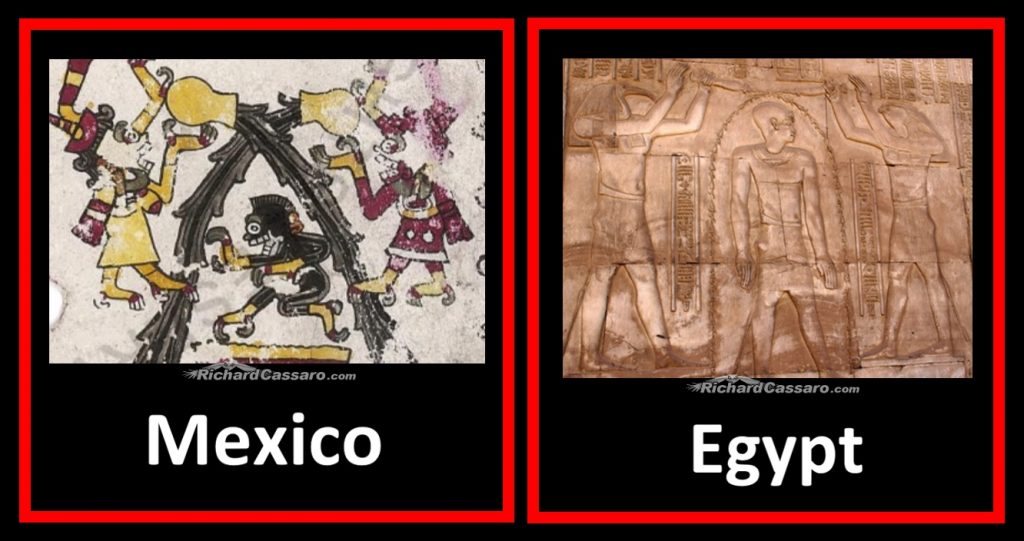
Left: Mesoamerican scene from the Codex Borgia, from south-central Mexico (Seler 1902–1923, II: codex page 31; cf. Díaz and Rodgers 1993, Plate 31), depicting what may be an initiation or baptism by water. Right: Egyptian scene from the Temple of Esna depicting what appears to be an initiation or baptism by water. According to John L. Sorenson, an emeritus professor of anthropology at Brigham Young University (BYU): “The Egyptian rite represented has become known as “the baptism of Pharaoh” (Gardiner 1950).”
Another interesting Maya / Egyptian parallel is visible in scenes that depict what look like initiation or baptism rituals. John L. Sorenson, emeritus professor of anthropology at Brigham Young University (BYU) wrote:
“…two ritual scenes are juxtaposed…one from Egypt… [and one] from the Codex Borgia…Mexico…dated shortly before the Spanish Conquest but surely it was based on earlier pictorial documents. While the two scenes differ in style, they share significant motifs. Shown are streams of water in the Mexican case and of ankh signs in the Egyptian scene, both of which in the respective traditions signified “life.” They are being poured by ritual officiants (divinities) positioned on either side of a central figure. The poured streams cross above his head. The Egyptian rite represented has become known as “the baptism of Pharaoh”…Over fifty years ago some of the corresponding characteristics of the two were pointed out to William F. Albright, the noted Syro-Palestinian archaeologist. He called the resemblance between the two scenes “most extraordinary” (personal communication, June 23, 1954) and continued that if the Mesoamerican scene had come from Mesopotamia “one would have to assume some connection” with Egypt.”
—John L. Sorenson, A Complex of Ritual and Ideology Shared by Mesoamerica and the Ancient Near East.
It is difficult to state with certainty what this parallel scene meant to the Egyptians and Maya. Did it have the same meaning for both cultures? The Egyptian scene has become known among scholars as the “baptism of Pharaoh,” because they are inclined to believe that it might have been a purification ritual.
Did the Mayan scene hold the same meaning? It is also possible that the symbolism shown here expresses the idea of initiation. Traditionally, the concept of initiation serves to reorient the individual away from his lower materialistic “animal” self. He is reoriented, instead, toward his higher “spiritual” Self and toward a more spiritual way of looking at the world. Water serves to cleanse, and it therefore appears possible that this parallel scene may depict a kind of initiation through cleansing, an idea that was apparently shared by both the Egyptians and Maya.
(C) PARALLEL TWIN SERPENT MOTIF

Left: Aztec sculpture featuring twin serpents facing opposite directions, often described as “The Double-headed serpent,” in the British Museum. Right: Egyptian Aten or sundisk symbols like this one appear above the main entrances to Egyptian temples and feature twin serpents emerging from the solar orb, facing opposite directions.
Another Mayan and Egyptian parallel is visible in the Twin Serpent motif. So-called “serpent bars,” depicting a serpent with twin heads and no tail, adorn the lintels of some Mayan temples, such as the Nunnery at Uxmal. Mayan statues and reliefs depict serpent bars in the hands of kings and priests. An example of this is depicted in the book, Ancient Civilizations of Mexico and Central America by Mesoamerican archaeologist Herbert Joseph Spinden (1879–1967). Spinden published the following drawings of Mayan serpent bars:
Note the similarity that these Mayan “serpent bars” share with the Egyptian Aten symbol, which adorns the lintels of some Egyptian temples, like Trojan’s Kiosk at Philae. Both the Mayan “serpent bar” and the Egyptian Aten symbol depict double-headed serpents connected back-to-back, facing opposite directions of left and right.
In the first example provided, we see Aztec symbolism showing the same “joined” twin serpent motif or double-headed serpent motif. Interestingly, we see essentially the same symbolism in Egypt, where a giant solar Aten symbol (which I believe signifies the soul/source) crowns the middle between the serpents.
5 – Human Jaguars (Maya) & Human Lions (Egyptians)
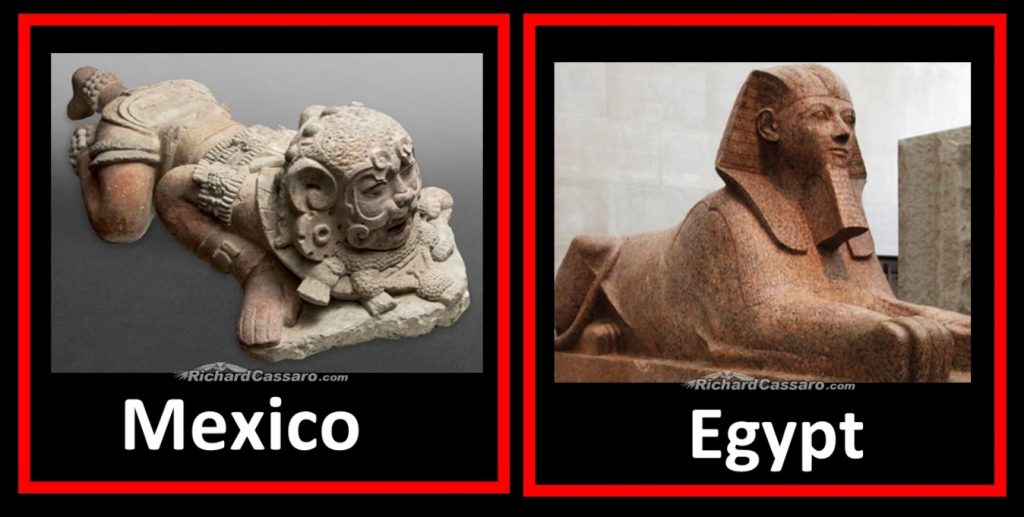
Left: A “were-jaguar” statue from the early classic period (ca. 250 AD- 600 AD), Maya lowlands, Peten, Guatemala. Right: The Sphinx of Hatshepsut, Egypt.
The Egyptians and Maya both created art and architecture depicting human beings transforming into, or having transformed into, felines. For the Egyptians, the feline was the lion; for the Maya, the feline was the jaguar.
Side-by-side comparisons of an Egyptian sphinx (a mythical creature with the head of a human and the body of a lion) with what Mesoamerican scholars describe as the “were-jaguar” (as in “werewolf”) reveal many commonalities. The term “were-jaguar” is derived from Old English were, meaning “man”, and jaguar, a large member of the cat family prevalent across Mesoamerica.
What exactly did this feline transformation theme on opposite sides of the Atlantic mean?
Researchers and philosophers have sought to decipher the meaning of the mysterious and colossal Sphinx statue that was buried in the desert sands for centuries before it was dug up and polished off in the early 1800s. Most contemporary Egyptologists, like Dr. Mark Lehner and Dr. Zahi Hawass, believe that the Sphinx was carved out of an outcropping during the reign of King Khafre, c. 2500 BCE; but many writers and archaeologists in past centuries, such as R. A. Schwaller de Lubicz, a nineteenth century French Egyptologist, occultist, and student of sacred geometry, believed the Sphinx to be the relic of an earlier epoch in world history, an extremely sophisticated and advanced lost civilisation (perhaps “Atlantis”) in remote antiquity.
Even today, there are many who do not agree with consensus estimates for the age of the Sphinx. The late rogue Egyptologist John Anthony West (1932 – 2018), taking a page from Schwaller de Lubicz, pointed to water erosion on the sphinx statue and the Sphinx enclosure wall as evidence of the monument’s vast antiquity.
It is well-known that sphinxes have been found among many ancient civilisations, not just the Egyptians and Maya. These civilisations include cultures in India, Phoenicia, Syria, China, Greece, Thailand, Japan, Sumer, and Sri Lanka. Egyptologists don’t yet seem to have “cracked the code” of the Sphinx, as they have not given any clear and decisive definition explaining exactly what the hidden meaning is behind this massive statue. This hidden meaning seems to be embodied not just in the Great Sphinx, but also in countless smaller sphinx statues depicting Egyptian kings and pharaohs in lionised form:
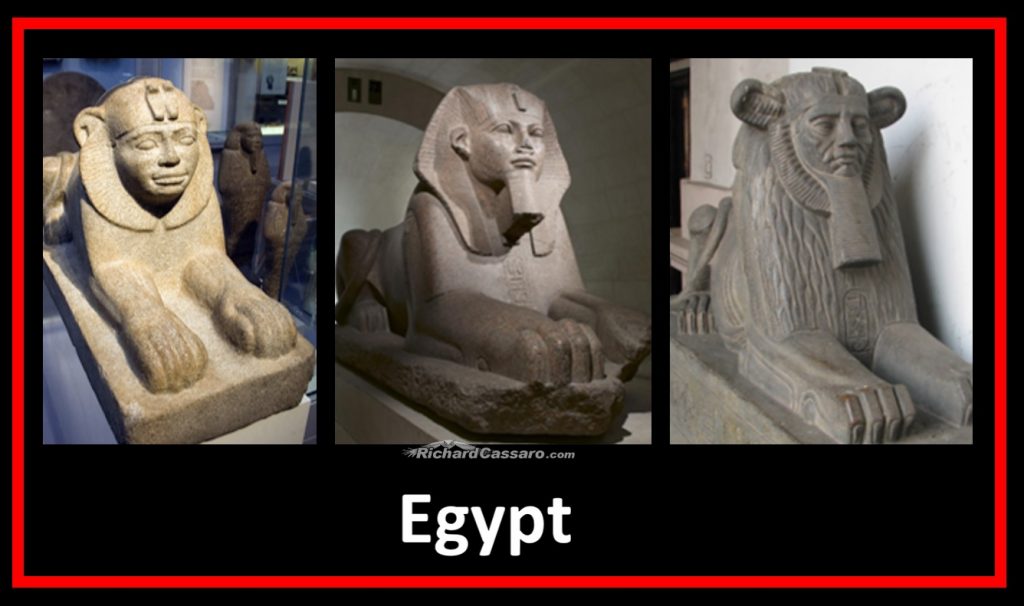
Shown here are three Egyptian kings depicted as sphinxes, converted into felines. Left: The Sphinx of Taharqo, a Nubian king ruling the Kingdom of Kush (Photo Courtesy of the British Museum). Middle: Great sphinx bearing the names of Amenemhat II (12th Dynasty), Merneptah (19th Dynasty) and Shoshenq I (22nd Dynasty). Right: Pharaoh Amenemhat III in the shape of a Sphinx.
When asked to explain the symbolic meaning of the sphinx, mainstream Egyptologists associate the sphinx with general concepts like “royalty” and the “monarchy” and with qualities of “majesty” and “nobility” and so on. But these descriptions do not answer the fundamental question, namely, why convert a human being (a king) into a lion? What does this human-into-feline symbolism mean? Just as Egypt’s pharaohs were depicted as lions, Mesoamerican (Olmec, Maya, Aztec) kings and rulers were depicted as jaguars. We can see this in the following examples:

Just like the Egyptians, the Maya and Olmec depicted themselves as felines (jaguars) in their art and architecture as evident in these figurines, which are typical of Mayan and Olmec iconography.
Dr. Nicholas Saunders, Senior Lecturer, Department of Archaeology and Anthropology, School of Arts, University of Bristol, explains:
“The jaguar is America’s largest and most powerful cat, and for more than three thousand years it has been Mexico’s most enduring symbolic animal. The jaguar’s image…prowls the art of most ancient Mexican civilizations, from the Olmec to the Aztec…the jaguar was identified with sorcery and magic, and regarded as the spirit-helper of shamans and sorcerers, as well as the most dazzling symbol of priests and kings…In pre-Columbian times, before the Spanish arrived, animal and human features were often combined to create what we regard as fantastical creatures possessing supernatural strength and magical powers. No surprise then that the kings and rulers of the Aztecs, the Maya, and earlier civilizations adorned themselves with jaguar skins, skulls, fangs and claws. Carvings, paintings or statues of humans wearing jaguar clothing or appearing to be half-human, half-jaguar, are more than simple artistic images – they represent fundamental ideas and beliefs of the Aztecs and their predecessors……Among the Classic Maya (AD 250-800), the jaguar’s brilliantly-coloured pelt was used as royal clothing for dynastic warrior-kings, and as a covering for royal thrones – some of which were carved in the shape of a feline, as at the Maya cities of Palenque, Uxmal, and Chichén-Itzá……Classic Maya rulers believed that using the jaguar’s name gave them prestige, and so there are examples where it has been attached to a king’s royal title. Similarly in death, archaeological evidence from Uaxactún and Kaminaljuyu in Guatemala, and Altun Ha in Belize reveals that Maya kings were buried with the animal’s skin, claws, and fangs.”
—Dr. Nicholas Saunders, The Jaguar in Mexico.
As demonstrated above, the Egyptians, in funerary monuments and public statuary, depicted their pharaohs as transforming or having transformed into feline sphinxes. Most Egyptologists believe that the colossal Egyptian sphinx on the famous Giza Plateau outside Cairo represents the Pharaoh Khafre. In his 2006 book, Mountain of the Pharaohs, Zahi Hawass, Egypt’s former Minister of State for Antiquities Affairs, wrote:
“Most scholars believe, as I do, that the Sphinx represents Khafre and forms an integral part of his pyramid complex.”
–Zahi Hawass, Mountain of the Pharaohs.
Given the fact that Egypt’s pharaohs depicted themselves as sphinxes (i.e., half man half feline creatures), what are the chances that ancient Mayan kings and rulers also depicted themselves as half man and half feline creatures? Can this be mere coincidence? Or does this parallel iconography on both sides of the Atlantic Ocean reveal some type of unexplained link between the Maya and Egyptians? How did “human-into-feline-transformation” become a cherished motif among both Maya and Egyptian kings?
4 – Parallel Third Eye Symbolism
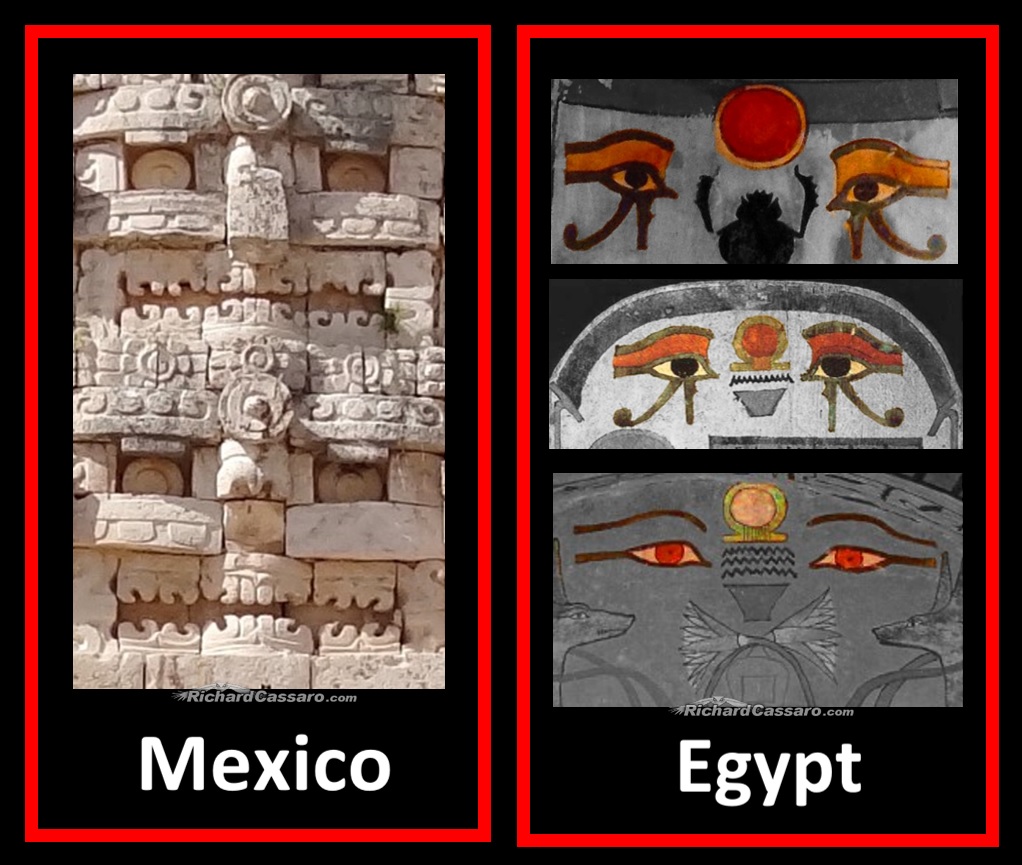
Both the Maya and Egyptians used the same Third Eye forehead dot symbolism. On the left, we see a relief from the Nunnery at Uxmal, Mexico, showing a circular dot in the location of the forehead. In India, this forehead dot is called “bindi” and it signifies the Third Eye chakra. On the right, examples from Egyptian tombs and steles show a similar “third eye forehead dot.”
For almost two decades, I’ve been pointing to the presence of Third Eye symbolism across the ancient world because I believe that the ancient art of “awakening the Third Eye” was a kind of universal religion that flourished in Antiquity, as-yet unrecognised by scholars.
There is ancient evidence of the Third Eye in Hinduism, where the Third Eye is symbolized by a dot on the forehead above and between the two eyes. This Third Eye dot, called “bindi” / “bindu,” “urna” and “trinetra,” is visible on images of the Buddha, gods, and bodhisattvas.
Is it possible that this same Third Eye symbol was known among ancient cultures outside Asia? I believe the answer is yes.
On the left, we see two so-called “Chac” masks encoded in Mayan architecture. They are stacked on top of each other, and each mask wears a giant circular stone on the forehead. The stone is in the same position as the Hindu “bindi dot,” which in India symbolises the Third Eye, a state of awakening and enlightenment.
On the right, in Egypt, the solar “aten” symbol crowns the forehead. In my opinion, the aten is a symbol of the soul / source. Shown here in the position of the Third Eye, the message is clear. According to ancient Hindu tradition, the act of awakening the Third Eye means awakening the eye of the soul and seeing the soul or source within.
“The third eye (also called the mind’s eye, or inner eye) is a mystical and esoteric concept of a speculative invisible eye which provides perception beyond ordinary sight.”
— Richard Cavendish, ed. (1994). Man, Myth and Magic – Volume 19.
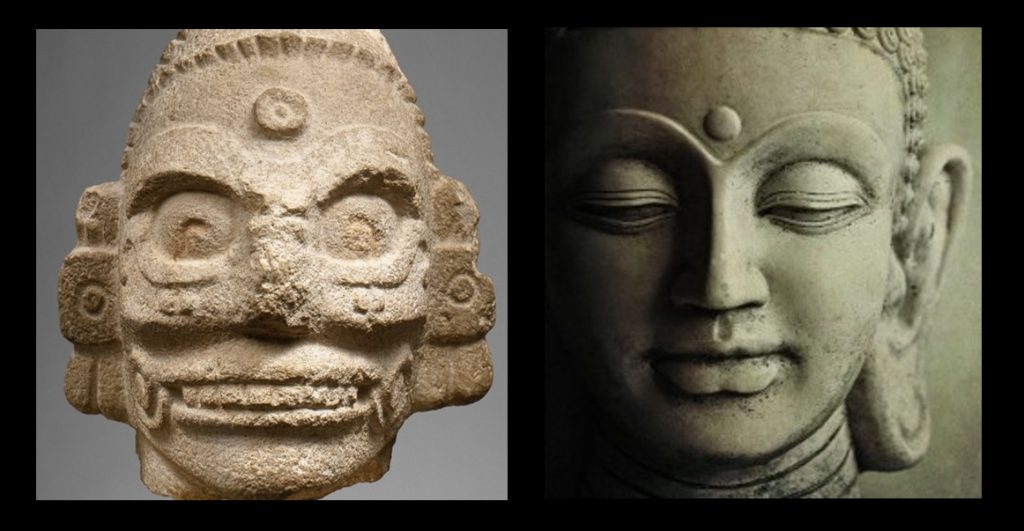
Ancient civilisations in the Americas, like the Maya and Aztecs (left), used the same forehead dot symbolism as Eastern cultures (right). Left: Head of a “rain god” (as described by scholars), with Third Eye “forehead dot,” found at Chichen Itza, Mexico. Right: Buddha image shown with bindi Third Eye “forehead dot,” typical of Asian statues.
Incredibly, and despite the fact that few scholars are willing to seriously entertain such a notion, the ancient Third Eye tradition of the Eastern hemisphere seems to have been a major cultural force in the Western hemisphere. As I explained in Written in Stone, we find a very Asian-like pattern of Third Eye symbolism among cultures that evolved and flourished in present-day Mexico, Guatemala, Belize, El Salvador, Honduras, Peru, Ecuador, Columbia, Panama, Costa Rica and even the United States. These cultures include the Olmec, Toltec, Maya, Zapotec, Aztec, Inca, pre-Inca, and Mississippian cultures. For an overview of my research into the Third Eye among the ancient Egyptians, please read my article “Third Eye in Ancient Egypt”.
3 – Parallel “Back-to-Back” Lions/Jaguars
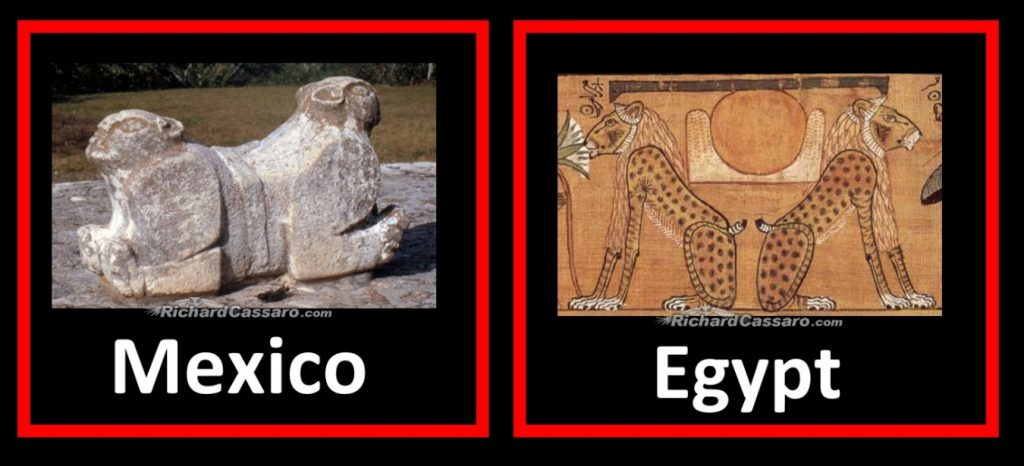
Left: Twin jaguars enmeshed as one, depicted in front of the Governor’s Palace at Uxmal, Mexico. Right: The Egyptian Aker Lions glyph, depicted on the Egyptian papyrus of Ani (Photo Courtesy of the British Museum).
The Maya and Egyptians both used the same “back-to-back” jaguars (Maya) and lions (Egyptians) motif. On the left, we see a statue in front of the Governor’s Palace at Uxmal, Mexico, depicting twin Mayan jaguars back-to-back. On the right, in the comparative image above, is a famous Egyptian “hieroglyph” or “god” or “motif” called Aker, depicting back-to-back twin lions.
“Aker appears as a pair of twin lions, one named Duaj (meaning “yesterday”) and the other Sefer (meaning “tomorrow”)…When depicted as a lion pair…a sun disc was put between the lions; the lions were sitting back-on-back.”
—Pat Remler, Egyptian Mythology, A to Z.
A famous explanation of the Aker Lions was provided by Schwaller de Lubicz, a student of Egyptian symbolism best known for his twelve-year study of the Temple of Luxor, who wrote that the image represents the “present” moment in time (symbolised by the solar Aten symbol) in comparison to the “past” and “future” (symbolised by the twin lions).
Schwaller de Lubicz indicated that the lion on the left corresponds to “yesterday” and faces west, while the lion on the right faces east and represents “tomorrow.” With the eternal sundisk (which I believe symbolises the “soul within” or “higher Self”) centred between the dual opposing lions, de Lubicz hypothesised that the entire Aker Lions hieroglyph seems to signify the “Eternal Now” moment.
The idea of an “eternal present” moment or the “eternal now” moment is a central concept in Eastern spiritual teachings and occult philosophy. It goes by the name “non-duality,” and we find it in Advaita Vedanta, Ch’an Buddhism, Zen, Taoism and Sufism.
“The Asian idea of nondualism developed in the Vedic and post-Vedic Hindu philosophies, as well as in the Buddhist traditions.”
—Sanghamitra Dasgupta and Dilip Kumar Mohanta, Indian Philosophical Quarterly # 25.
There is a symbol in Mayan art and iconography that is similar to the Egyptian Aker Lions hieroglyph. This Mesoamerican counterpart depicts the image of twin jaguars and twin jaguar-like humans. Like the Aker lions in Egypt, the Mesoamerican jaguars are facing opposite directions, which, in my opinion, indicates that they symbolise duality. In some cases, not only are the jaguars lying back-to-back (close together and facing opposite directions) just like in Egypt, but they are also lying in such a way that their physical bodies are enmeshed. This gives the impression that their duality has been united, and they have combined into a single being—a double-headed jaguar.
Below are three examples from Mayan art compared with Egypt’s Aker lions:

Top left column: Maya statue depicting twin jaguars back-to-back in front of the Governor’s palace at Uxmal, Mexico glyphs. Middle Left Column: Twin jaguars shown back-to-back on the Nunnery at Uxmal, Mexico. Bottom left column: Twin sphinx-like humans shown back-to-back depicted on the Pyramid of the Magicians at Uxmal, Mexico. Right column: Egyptian Aker Lions glyphs from Egyptian papyri.
Did this “twin jaguar” symbol have the same meaning among the Maya as the Aker Lions symbol among the Egyptians?
Based on this symbolism, one could argue that Egypt’s Aker Lions symbol signifies the unification of opposites into the centre principle, the Aten or sundisk, which I believe symbolises the soul. In my book, Mayan Masonry, I present detailed evidence for the notion that in Mexico, the twin jaguar motif symbolises the unification of opposites into a kind of centre principle, where the two jaguars become a single and more powerful entity. This reflects a deep, metaphysical wisdom teaching that explains the concept of nonduality.
2 – Parallel Tau Cross
Le Plongeon found an even more amazing similarity that ties the Egyptian and Maya cultures to each other, and to Freemasonry. In his book, Sacred Mysteries Among the Mayas and the Quiches, Le Plongeon expressed his belief that the Egyptians and Maya used the very same Tau cross in a way that made him believe it had the same meaning in both Egypt and Mexico.
The Tau was a symbol used by ancient cultures in Greece, Ireland, Spain, Egypt, and Mexico (see image below). Its use by the Egyptians and Maya fascinated Le Plongeon.
How did both cultures, separated by the Atlantic Ocean, come to adapt the same Tau cross for thousands of years?
The Tau cross is also a very important Masonic symbol, appearing on Masonic tracing boards, aprons, jewellery, and more:

Left: Tau Cross that once stood on Roughan Hill, Ireland, now in the Clare Museum. Middle: Talaiot de Trepuco, megalithic Tau-shaped Taula monument on Menorca island, Spain. Right: The so-called “Triple Tau” is described in Freemasonry as the “Grand Emblem of Royal Arch Masonry.”
As a Freemason, Le Plongeon certainly knew the importance of the Tau. He felt that the only way the Egyptians and Maya could have both possessed the Tau was via the same source. For Le Plongeon, this meant that both civilisations somehow had access to the same teachings:
“the “Crux Ansata,” …”‘symbol of symbols” among the Egyptians…It was placed on the breast of the deceased, sometimes as a simple T …sometimes represented as supported on a heart. It is also seen adorning the breasts of statues and statuettes in Palenque, Copan, and other ancient cities of Guatemala, Nicaragua, and various localities of Central America…
The origin and meaning of the mystical T, that symbol of “hidden wisdom” as it has been denominated by scholars of our days, found on all Egyptian monuments, in the temples, in the hands of the gods, in the tombs on the breast of the mummies, also met with in the ancient edifices of Maya and on the statues and altars in the temples of Palenque.”13
—Augustus Le Plongeon, Sacred Mysteries Among the Mayas and the Quiches.
For the Maya and Egyptians, the Tau was no insignificant object. They used it in their art, architecture, funeral rituals, ceremonies, on their altars and thrones, in their jewellery, and they depicted themselves and their gods holding the symbol on statues and reliefs, as shown in the images above.
More commonly known in Egypt as the “ankh,” the T cross is an ancient Egyptian hieroglyphic ideograph symbolising “life” in the sense of the “eternal life” or spiritual life of the soul. The ankh has a loop handle, partly disguising the T and Tau cross. However, the Egyptian ankh is no less a letter T than the Maya T cross. We should keep in mind that its Latin name, crux ansata, means “cross with a handle.”
In 1994, the uncovering of T-shaped stone pillars among the world’s oldest dated megaliths at the famous archaeological site of Göbekli Tepe provided stunning confirmation that the Tau cross played a major role among the most ancient civilisations around the world.
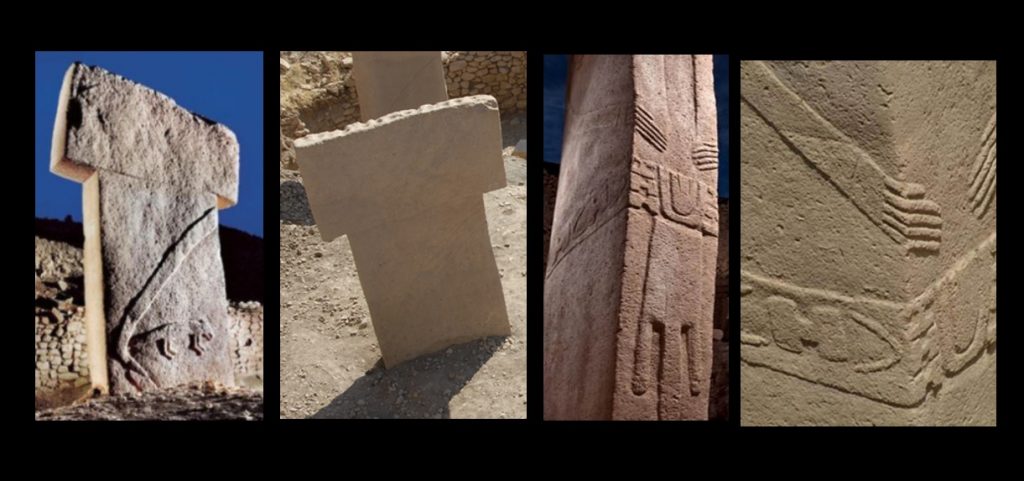
Tau-shaped “T” pillars at the ancient site of Gobekli Tepe, depicting human arms and hands shown in relief.
Interestingly, Göbekli Tepe’s T-shaped pillars are giant abstract images of the human form. Arms and hands are visible on the megaliths, as if uniting the T with the human body, as shown in the image above:
“The characteristic element of Göbekli Tepe’s architecture are the T-shaped pillars. In the older Layer III (10th millennium BCE) the monolithic pillars weigh tons and reach heights between 4 m (pillars in the stone circles) and 5.5 m (central pillars). The T-shape of the pillars is clearly an abstract depiction of the human body seen from the side. Evidence for this interpretation are the low relief depictions of arms, hands and items of clothing like belts and loincloths on some of the pillars.”
—Oliver Dietrich, The Tepe Telegrams.
Incredibly, the Egyptian Tau cross was sometimes personified—depicted with arms and legs.

Left: The Egyptian Tau Cross was often shown personified; here it is depicted with arms on an ancient Egyptian wall frieze at the Temple of Sobek and Haroeris, Kom-Ombo. Right: The T-shaped pillars of Göbekli Tepe—which I believe symbolise the Tau Cross—are shown in human form.
That Gobekli Tepe’s T-shaped pillars and ancient Egypt’s Tau cross were both anthropomorphised provides compelling evidence of a possible, even likely, connection between the two cultures. This powerful cross symbol has, of course, been appropriated by Christianity.
1 – Matching Triptych Temples
I researched the ruins of Triptych Temples all over the ancient world—and most pronouncedly among the pyramid cultures—in the late 1990s, and, as demonstrated in my 2011 book Written in Stone, these temples all celebrate the same universal religion (Perennial Philosophy) of non-duality that was shared across all of antiquity.
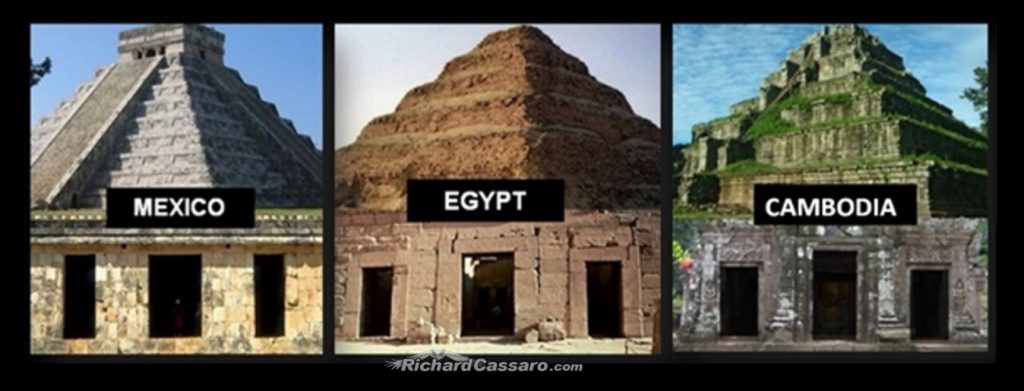
Left: Pyramid of Kukulkan, Chichen Itza, Mexico. Triptych Temple of the Turtles in Uxmal, Mexico. Middle: Pyramid of Saqqara, Egypt. Triptych Temple of Seti II, Karnak, Egypt. Right: Koh Ker pyramid in Cambodia. Triptych Temple at Ta Prohm in Cambodia.
The pyramid-cultures all built “Triptych” three-door temples, with a wider and taller middle door than the two flanking it. The abundant occurrence of the Triptych across the ancient world is not a random coincidence. The Triptych represents more than merely an architectural element; the Triptych is the chief symbol of an advanced universal religion (perennial philosophy) that was once shared globally in antiquity, mainly by the pyramid cultures.
In my books, I have shown how the twin outer doors of Triptych Temples symbolise duality, or the “pairs of opposites”; the centre door symbolises the unity of the twin outer doors or the “balance of duality” (i.e., non-duality).
Egyptologists and Mayanists recognise that the concept of non-duality (also called the “balance of opposites”) formed an essential feature of core wisdom-teaching among the ancient Egyptians and the Maya:

Left: Temple of the Turtles, Uxmal, Mexico. Right: Temple of Seti II in the atrium of the temple of Karnak, Egypt.
“…the deeply rooted Egyptian tendency [is] to understand the world…as a series of pairs of contrasts balanced in unchanging equilibrium…The dualistic forms…embody the…Egyptian thought that a totality comprises opposites.”
— Henri Frankfort, Kinship and the Gods, 1948.
“…the basic concept of the Maya religion and that of Mesoamerica in general is the harmony of opposites…”
— Mercedes de la Garza, Maya, 1998
The discovery of the Triptych provides evidence that ancient cultures worldwide shared the same spiritual beliefs, and that they encoded their beliefs in the parallel Triptych Temples that they designed and built. This discovery suggests that these cultures descended from the same remote parent source.
The ancient Mayan and Egyptian cultures do not seem to have been in contact with one another. There are no records of trade or warfare or any other types of trans-Atlantic communication. What’s more, there are many differences between the two cultures that are just as powerful as their similarities. For example, the Mayan ball game was a central feature of their culture; I have never heard of any Egyptian ball games. Also, the art of mummification does not seem to have played a key role in the Maya funerary ritual, as it did in Egypt.
To compare the two civilisations is at first blush manifestly unfair to the Maya, who were denied their say in history by both their isolation from the rest of the civilised world and because of the intentional destruction of the lion’s share of their cultural patrimony by the Spanish conquistadors. We will most likely never be able to read about the great exploits of the Maya counterparts, if such ever existed, to those of Cleopatra, King Tut, Rameses and Akhenaten.
Nonetheless, there is ample reason to believe, based on the striking parallel iconography and cultural phenomena I have presented here and elsewhere, that both civilisations evolved from the same more ancient parent culture or source civilisation—a mother culture so old that it has now been lost to time. Both cultures seem to have somehow shared the same religious tradition—as if they started off with the same body of metaphysical wisdom, albeit expressing this wisdom in slightly different ways, using their own “local dialect” in a sense. This is the theory that I put forth in my 2011 book, Written in Stone, and further flesh out in Mayan Masonry, where I look at several more profound Mayan and Egyptian parallels, as well as a panoply of other remarkable parallels shared by the Maya and other ancient civilisations.
Is it possible that these civilisations may be children of the same Mother Culture? Could they have descended from the same more ancient source without knowledge of each other? I think the astonishing answer may well be yes! As to what that Mother Culture was, and how it spread its tentacles throughout the ancient world, we don’t have all the answers yet. Despite some intriguing recent finds and reinterpretations of ancient artefacts, the source of ancient religious belief remains elusive in many respects; but I’m still digging and still sorting through a continuously-updated database of archaeological information. Watch this space!
About the author
Richard Cassaro is a Madrid-based author, lecturer, documentary filmmaker, and tour guide from New York City. His published books Written in Stone (2011), The Missing Link (2016), and Mayan Masonry (2018) offer rare insights into ancient megaliths, spirituality, mythology, magic, symbolism, secret societies, comparative religion and occult archaeology. Cassaro has discussed his work on the History Channel, and in documentary films including Magical Egypt 2. His articles have appeared in print journals and web media around the globe; and he has delivered well-received lectures about his findings in England, Italy, Peru, Egypt, Spain, Mexico, Cyprus, and the U.S. In his capacity as a field investigator, he hosts travel adventures to archaeological sites worldwide.
Bibliography
Ayer A, Campbell A, Appelboom G, Hwang BY, McDowell M, Piazza M, Feldstein NA, Anderson RC., “The Sociopolitical History & Physiological Underpinnings of Skull Deformation,” Neurosurgical Focus (2010).
Brunhouse, Robert L., In Search of the Maya (University of New Mexico Press, 1973).
Cassaro, Richard, Written in Stone (Deeper Truth Books, 2011).
Dasgupta, Sanghamitra; Mohanta, Dilip Kumar, Indian Philosophical Quarterly, 25 (1998).
De la Garza, Mercedes, Maya, (Rizzoli, 1998).
De Lubicz, Schwaller R.A., The Temple in Man (Inner Traditions paperback, 1981).
Desmond, Lawrence Gustave, A Dream of Maya (University of New Mexico Press, 1988).
Dietrich, Oliver,“The Current Distribution of Sites with T-Shaped Pillars” (The Tepe Telegrams, 2016).
Donnelly, Ignatius, Atlantis: The Antediluvian World (Harper & Brothers, 1882).
Feder, Kenneth, Frauds, Myths, and Mysteries (Oxford University Press, 2017).
Feder, Kenneth, Encyclopedia of Dubious Archaeology (Greenwood Publishing Group, 2010).
Frankfort, Henri, Kingship and the Gods (Oriental Institute of the University of Phoenix, 1948).
Hancock, Graham, Magicians of the Gods (Thomas Dunne Books, 2015).
Hawass, Zahi, The Secrets of the Sphinx (The American University in Cairo Press, 1998).
Helferich, Gerard, Humboldt’s Cosmos (Gotham Books, 2004).
Higgins, Frank, Ancient Freemasonry (Kessinger Publishing, 2010).
Hornung, Erik, The Secret Lore of Egypt (Cornell University Press, 2002).
Lehner, Mark, The Complete Pyramids (Thames and Hudson, 1997).
Le Plongeon, Augustus, Queen Móo and the Egyptian Sphinx (Published by the Author, 1900).
Le Plongeon, Augustus, Sacred Mysteries Among the Mayas and the Quiches (Theosophical Publishing Company, 1909).
Le Plongeon, Augustus, The Origin of the Egyptians (The Word Magazine, Vol. 17, 1913-1914).
Nuttall, Zelia, The Fundamental Principles of Old and New World Civilizations (Peabody Museum of American Archaeology & Ethnology, 1901).
Remler, Pat, Egyptian Mythology, A to Z (Chelsea House Publishers, 2010).
Romero-Vargas S1, Ruiz-Sandoval JL, Sotomayor-González A, Revuelta-Gutiérrez R, Celis-López MA, Gómez-Amador JL, García-González U, López-Serna R, García-Navarro V, Mendez-Rosito D, Correa-Correa V, Gómez-Llata S., “A Look at Mayan Artificial Cranial Deformation Practices: Morphological and Cultural Aspects,” Neurosurgical Focus (2018).
Saunders, Nicholas, The Jaguar in Mexico.
Sorenson, John L., “A Complex of Ritual and Ideology Shared by Mesoamerica and the Ancient Near East,” Sino-Platonic Papers (2009).
Spinden, Herbert Joseph, Ancient Civilizations of Mexico and Central America (New York American Museum Press, 1922).
Stevens, John Lloyd, Incidents of Travel in Central America, Chiapas and Yucatán (Cambridge University Press, 2010).
Wauchope, Robert, Lost Tribes and Sunken Continents (University of Chicago Press, 1962).
West, John Anthony, Serpent in the Sky (Quest Books, 1993).
Wolfgang von Hagen, Victor, Maya Explorer (University of Oklahoma Press, 1947).






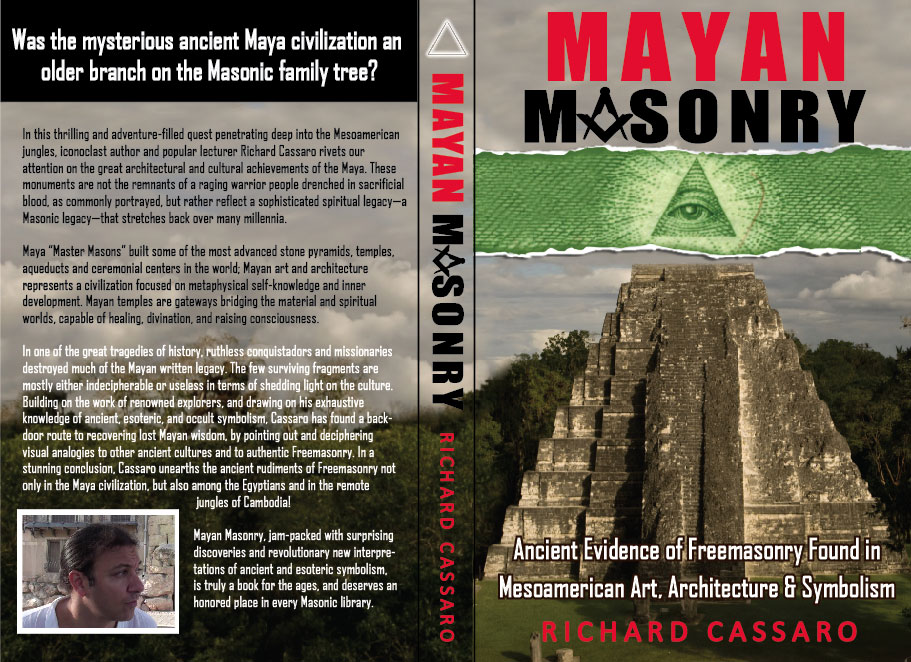
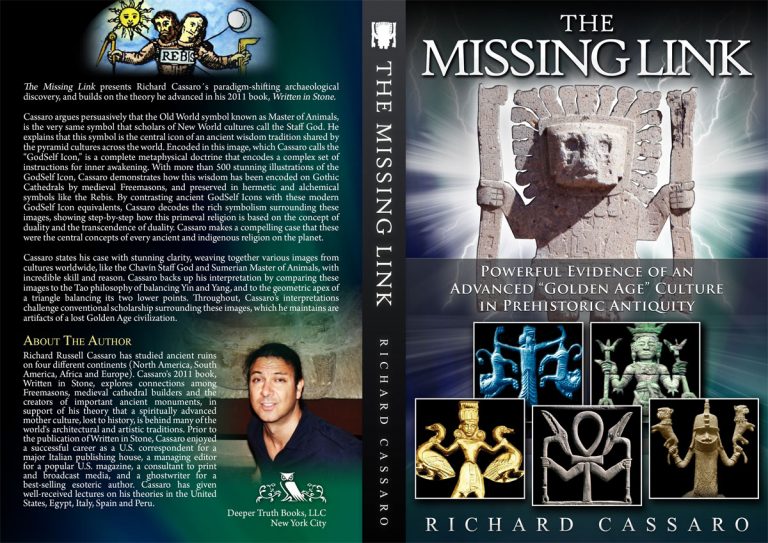


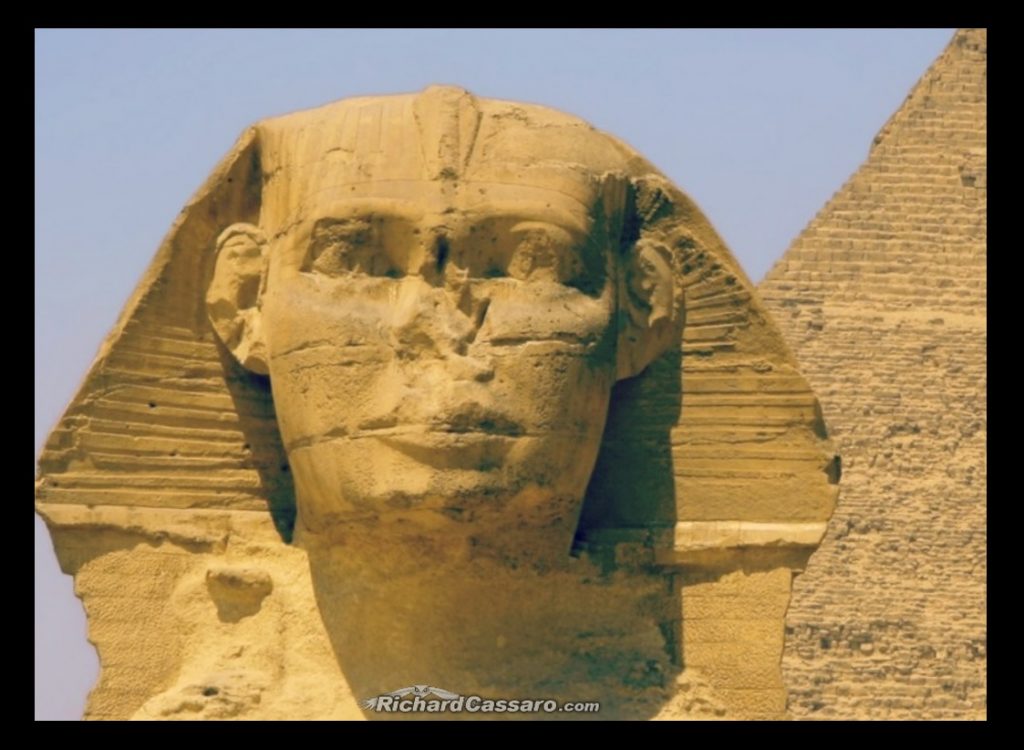

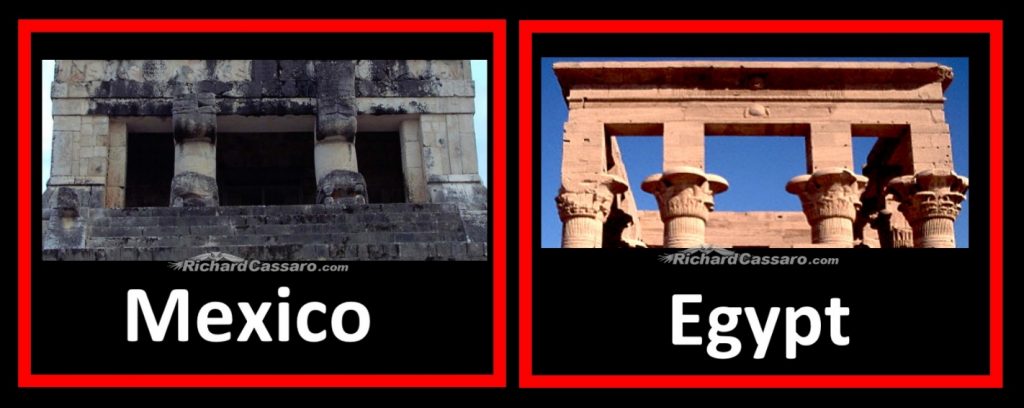
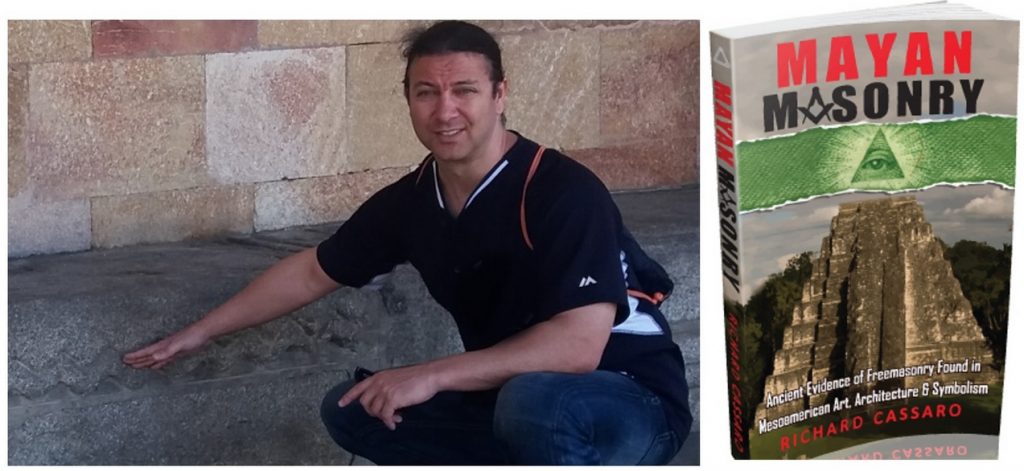
“Admittedly, the idea that both the Mayan and Egyptian elite practiced cranial deformation to perhaps differentiate them from the lower classes does not directly connect the two civilisations.”
Personally Richard I suspect it may connect those two civilizations as much as the other evidence.
Think about it. Why would two separate groups struggling with daily existence not only come up with the same idea of deforming their kids’ skulls but then spend god knows how many years – how many generations for that matter! – experimenting with countless methods and techniques until they finally achieved a methodology and a transformed adult to justify the whole process?
Great article. Just one thing though, apologies for being pedantic but the song ‘Ebony and Ivory’ is sung by Paul McCartney and Stevie Wonder, not Michael Jackson.
Excellent!!! Three for three. A most worthy addition to the other two, “Written in Stone” and “Missing link.” There’s something about that Triptych stuff and stoneware, to be sure. Your books and web site and observations are three invaluable resources to take along on masonry related explorations.
I really enjoy your thoughts and observations, based on such comprehensive research and wonderful photographic illustrations.The concept of “The Eternal Now” bracketed between the opposites of yesterday and tomorrow and its balance/harmony of duality fits so well with your explanation of the Godself with physical and spiritual offshoots. This undying religious principle was forcefully brought to life again for me with the fire at Notre Dame. The three arches of the facade were so prominent. It is so universal, in the Christian Trinity mystery with the Father, the physical son sacrificed at this time and the spiritual essence visiting his followers to fill them with enlightenment. It is also mirrored in Freud’s ego, torn apart by the conflict between id and superego – described as somebody trying to drive blindfolded while a monkey beats him to go faster and a grandmother screams at him to go slowly. The Tau image at Gobekli Tepe is so strong that it stands out next to the H symbol for non-duality and the Christian cross symbol for sacrifice of the corporeal – T H + – easy to recognise and respond to. Maybe the circular symbols at locations such as New Grange in Ireland are devoted to female religious beliefs. Thank you so much again for your thought provoking and illuminating work and the inspiring visual prompts that you use to demonstrate your argument. More strength to your elbow, Nigel
Interesting Article.
Origin of ‘werewolf’. The French equivalent which is ‘loup garou’ comes with almost no distortion from the Sumerian symbols LU₂-GAR, which have the meanings of ‘man’ and ‘measure’ or ‘place’. Thus, French ‘loup’ incorporates both wolf and man, and it is quite possible that the English ‘wer’ sound originates with Sumerian GAR. The symbols appear together twice on lines 184 and 185 of The Instructions of Shuruppak (re-translated by me) as ‘Man his measure to take, man his measure not to take’ in the (humorous) context of a decision to be made about humanity by an unknown celestial hand (unfortunately the tablets are broken at that point). Like most of the Sumerian writing, it incorporates a play on words, a riddle; in this case it could have read as ‘the place of man to take’.
A few more points. There are Mesopotamian tablets with seals showing pots that have a strange upward flow. If you change the angle, they are not dissimilar to the Codex Borgia scene you show here. The third eye, the origin of the Tau and the word ‘baptism’ are all mentioned in my upcoming book about the original language. I appreciate the fact that you have interpreted images of the killing scenes as potentially highly spiritual. The only error I find is your suggestion that the mother culture is lost to time. We still possess the language of it. An interesting article. Thank you.
Madeleine
I have been a keen follower of Mr. Hancock and therefore I am aware of the similarities between the cultures. However, I believe it is not very right to put so much emphasis on pyramids shaped structures and arched vaults.
As a civil engineer, I can say that the easiest way of building a high-rise structure is to build a structure that is called a “self-supporting structure” and they include pyramids, domes and tunnels. Imagine that you are building a house made of a deck of cards; the first thing you do is put the top ends of two cards facing each other so that they form a triangle with the floor. These walls (cards) support each other so that they can stand tall. The vault structures above use the same logic; they put stones after stones with little slippages towards each other until they meet at one point to support each other. Pyramids are also same, each wall facing the other, supports it as well.
This is a very primitive architectural method and not very efficient because you need a very large base area if you want to go high. Since they lack the technology about columns and beams (they had them but could not build several storey structures), this is quite understandable. Even if they had this technology beams and column structure do not withstand earthquake (unless they had 21st century methods), unlike pyramid structures. Besides, stepped pyramid in Egypt is one of its earliest examples, before the Egyptians perfected their skills by eradicating the steps, as this process required further calculation/additional effort/practice.
I am also not impressed with human headed jaguar/lion figures because throughout history rulers always wanted to show their or their god’s powers. In my opinion merging the human with the fiercest animal known to that society is not unnatural. Even today we want to be as strong as a bear or to have eyes like an eagle. That is simply what they did in those years, merged themselves with animals. What is unnatural is adding an animal face to a human body, the thing that the Egyptians did. If you want to look as strong as an animal, you normally would want to keep your face so that people understand that it is you (or any human). It would be magnificent if the Egyptians had jaguar shaped statues, that would really mean a lot because jaguar is not a native animal to Africa.
With the same logic, strong animals facing different directions (back to back), emphasize security, a feeling that all cultures needed. Even many family coat of arms today have fierce animals facing other directions.
Although they were separate cultures divided by an ocean, their needs and logics may be similar because they were human in the end with the similar needs. Just because two separate people on the other side of an ocean suddenly started fishing, does not mean that they were related. They both saw the fish and decided to catch it, it may be that simple.
I agree, it’s worth noting that the Maya generally were far later than the Egyptian pyramid building cultures.
As you mention, pyramids are essentially mounds, it’s the way you naturally create a big, tall structure. In fact, some of the Mayan temples were far steeper even than the Sudanese pyramids, not all of them were like the Chichen Itza pyramid, which is one of the few Mayan structures which actually looks like a real pyramid, most of the Mayan “pyramids” don’t really look like pyramids at all and they are far smaller than the Egyptian pyramids.
I mean, how can structure II in Calakmul be considered a pyramid, how can the Uxmal complex temple building be considered a pyramid? Those buildings looks nothing like any Egyptian structures.
Also, the glyphs are really not similar at all, and again, the Mayan glyphs were a much later development than the Egyptian writing, separated by at least a thousand years or two.
The egyptian pyramids after the first became smooth sided, while that didn’t happen for the Mayan “pyramids” or even the other Mesoamerican pyramids.
If you look at Chichen Itza pyramid of Kukulcan, it is quite obvious that the steps are not for structural reasons, they are a design choice. Same can be said for Temple I at Tikal, it has very steep sides, it would not need the steps except as a design choice. The most pyramidal of all the Mesoamerican temple mounds is the Pyramid of the Sun, which is not Mayan. It is of comparable size to the Egyptian pyramids. It is, however, still stepped, but in that structure it is quite obvious that it doesn’t need to be for any other reason than design choice.
None of that implies that there weren’t any previous relatively advanced civilization, but I don’t think there was a mother culture for those very different later civilizations, since they were separated so far in time.
Might the ring of large stones at Stonehenge represent a circle of TAU symbols, making the space inside very “auspicious?
Has anyone been to Cahokia or Emerald Mounds? Has anyone ever read The Book of Mormon not for spiritual meaning but for archaeological information?
Be excellent to each other…and yourself….fascinating, and enlighening. So much to contemplate. What i most find interesting is that Asia and South American cultures share similar flora and fauna. Regarding ginseng, and not mentioned, the lotus in all 3 cultures. Makes one wonder if the religious similarities might come from the use of these and other similar compounds they all share….
Always wondered if there was contact between Asia and America in ancient times. It’s hinted at in my interpretation of Plato’s Atlantis story – a lost world beyond the pillars of Hercules. I believe Plato’s story is a merging of two different stories – one a memory of the volcanic destruction of maybe Santorini, and the second an entirely separate memory of a civilisation across the Atlantic.
There is archaeological proof of trade between the Eastern Mediteranean and the British Isles around the coast via Spain in Bronze Age times. The Vikings are proven to have gone to America.
Pyramids in Egypt are thought to have developed from small burial mounds which got larger over time. In America there are also burial mounds although I don’t know the timeline. In Ireland (Newgrange) and Bulgaria (Bronze Age sites) the story is similar though the mounds were circular in these places. Of course the purpose of Silbury Hill in England is still a mystery. In America the flat tops of the structures were used for ceremonial structures, as in the zigurats of Mesopotamia.
Stonehenge and its avenues have been said to represent in plan a serpent with an egg in its belly. There is at least one earthwork in North America with a similar plan.